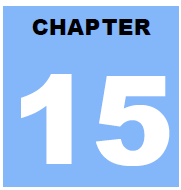
Assembly Strings
We have already used variable lengths strings in our previous examples. You must have noticed that, the variable lengths strings can have as many characters as required. Generally, we specify the length of the string by either of the two ways:
Explicitly storing string length
Using a sentinel character
We can store the string length explicitly b y using the $ location counter symbol, that represents the current value of the location counter. In the following example:

$ points to the b yte after the last character of the string variable msg. Therefore, $-msg gives the length of the string. We can also write

Alternativel y, you can store strings with a trailing sentinel character to delimit a string instead of storing the string length explicitly. The sentinel character should be a special character that does not appear within a string.
For example:

String Instructions
Each string instruction may require a source operand, a destination operand, or both. For 32 -bit segments, string instructions use ESI and EDI registers to point to the source and destination operands, respectively.
For 16-bit segments, however, the SI and the DI registers are used to point to the source and destination respectively.
There are five basic instructions for processing strings. They are:
MOVS - This instruction moves 1 Byte, Word or Doubleword of data from memory location to another.
LODS - This instruction loads from memory. If the operand is of one byte, it is loaded into the AL register, if the operand is one word, it is loaded into the AX register and a doubleword is loaded into the EAX register.
STOS - This instruction stores data from register (AL, AX, or EAX) to memory.
CMPS - This instruction compares two data items in memory. Data could be of a byte size, word or doubleword.
SCAS - This instruction compares the contents of a register (AL, AX or EAX) with the contents of an item in memory.
Each of the above instruction has a byte, word and doubleword version and string instructions can be repeated by using a repetition prefix.
These instructions use the ES:DI and DS:SI pair of registers, where DI and SI registers contain valid offset addresses that refers to bytes stored in memory. SI is normally associated with DS (data segment) and DI is always associated with ES (extra segment).
The DS:SI (or ESI) and ES:DI (or EDI) registers point to the source and destination operands respectively. The source operand is assumed to be at DS:SI (or ESI) and the destination operand at ES:DI (or EDI) in memory.
For 16-bit addresses the SI and DI registers are used and for 32 -bit addresses the ESI and EDI registers are used.
The following table provides various versions of string instructions and the assumed space of the operands.

MOVS
The MOVS instruction is used to copy a data item (byte, word or doubleword) from the source string to the destination string. The source string is pointed by DS:SI and the destination string is pointed by ES:DI.
The following example explains the concept:
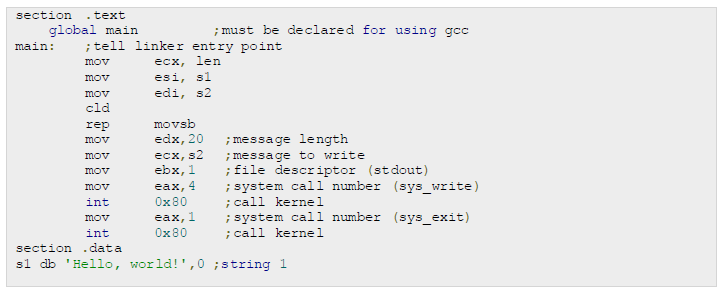

When the above code is compiled and executed, it produces fol owing result:

LODS
In cryptography, a Caesar cipher is one of the simplest known encryption techniques. In this method, each letter in the data to be encrypted is replaced by a letter some fixed number of positions down the alphabet.
In this example, let us encrypt a data by simply replacing each alphabet in it with a sh ift of two alphabets, so a will be substituted by c, b with d and so on.
We use LODS to load the original string 'password' into the memory.
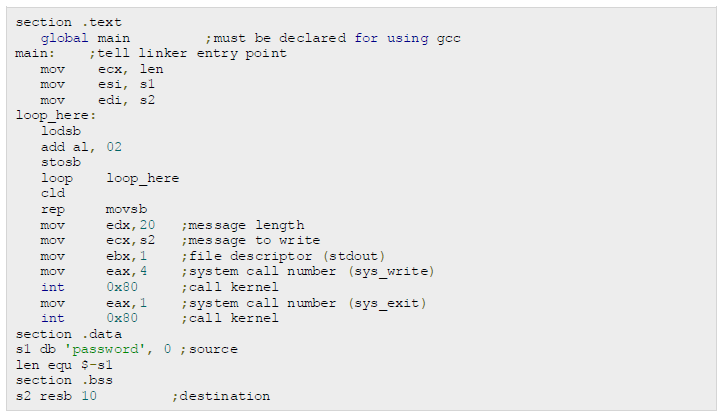
When the above code is compiled and executed, it produces following result:

STOS
The STOS instruction copies the data item from AL (for b ytes - STOSB), AX (for words - STOSW) or EAX (for doublewords - STOSD) to the destination string, pointed to by ES:DI in memory.
The following example demonstrates use of the LODS and STOS instruction to convert an upper case string to its lower case value:

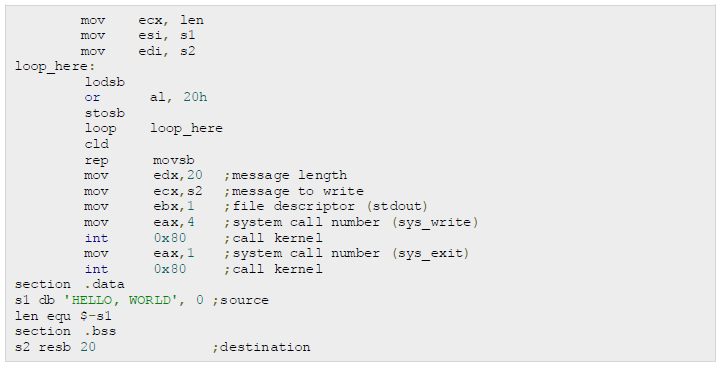
When the above code is compiled and executed, it produces fol owing result:

CMPS
The CMPS instruction compares two strings. This instruction compares two data items of one byte, word or doubleword, pointed to by the DS:SI and ES:DI registers and sets the flags accordingly. You can also use the conditional jump instructions along with this instruction.
The following example demonstrates comparing two strings using the CMPS instruction:
section .text
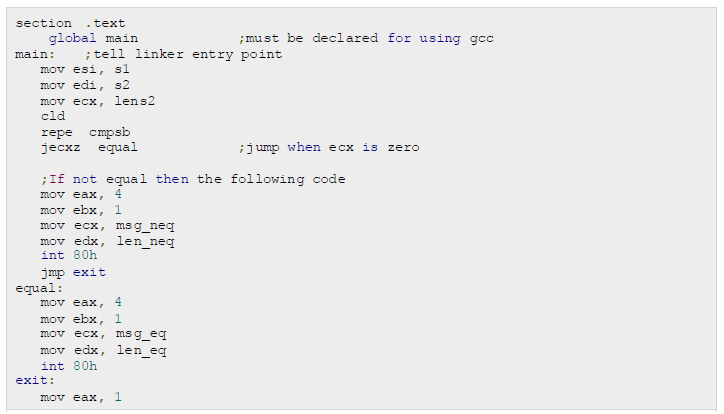

When the above code is compiled and executed, it produces fol owing result:

SCAS
The SCAS instruction is used for searching a particular character or set of characters in a string. The data item to be searched should be in AL (for SC ASB), AX (for SC ASW) or EAX (for SC ASD) registers. The string to be searched should be in memory and pointed by the ES:DI (or EDI) register.
Look at the following program to understand the concept:
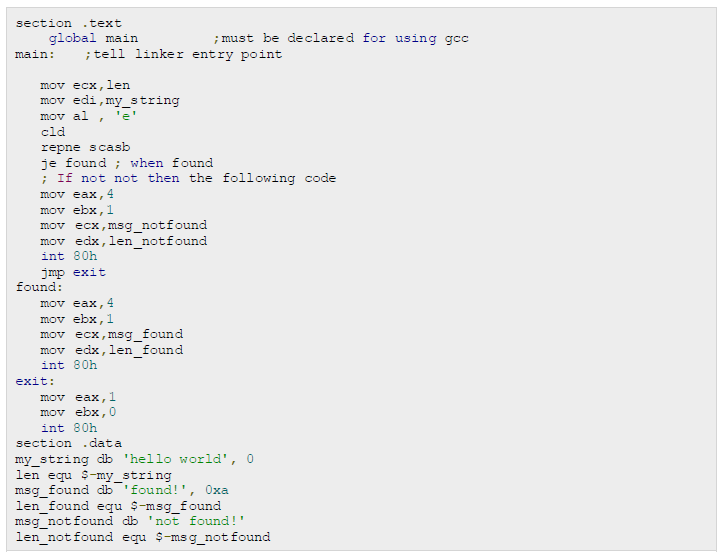
When the above code is compiled and executed, it produces fol owing result:

Repetition Prefixes
The REP prefix, when set before a string instruction, for example - REP MOVSB, causes repetition of the instruction based on a counter placed at the CX register. REP executes the instruction, decreases CX by 1, and checks whether CX is zero. It repeats the instruction processing until CX is zero.
The Direction Flag (DF) determines the direction of the operation.
Use CLD (Clear Direction Flag, DF = 0) to make the operation left to right.
Use STD (Set Direction Flag, DF = 1) to make the operation right to left.
The REP prefix also has the fol owing variations:
REP: it is the unconditional repeat. It repeats the operation until CX is zero.
REPE or REPZ: It is conditional repeat. It repeats the operation while the zero flag indicate equal/zero. It stops when the ZF indicates not equal/zero or when CX is zero.
REPNE or REPNZ: It is also conditional repeat. It repeats the operation while the zero flag indicate not equal/zero. It stops when the ZF indicates equal/zero or when CX is decremented to zero.














